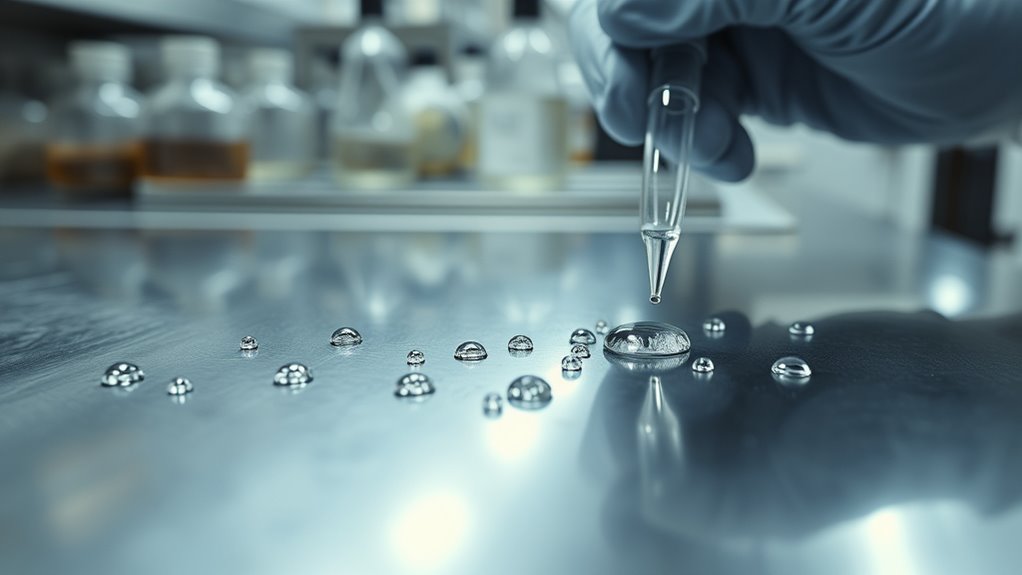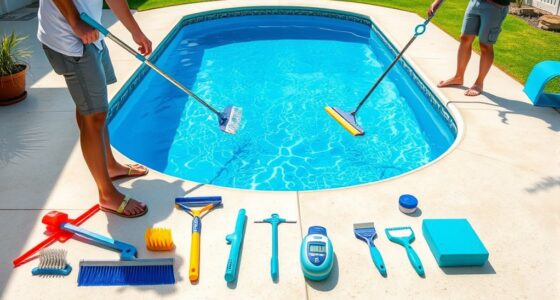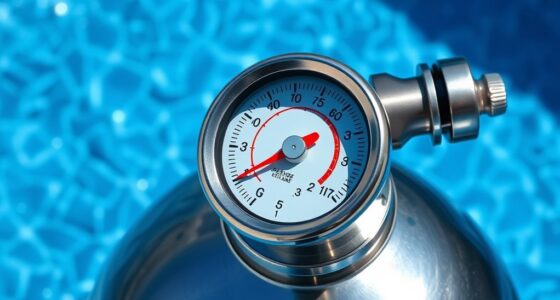To manage metals effectively, identify common sources like plumbing fixtures, soil, and corrosion in equipment that release metals into your environment. Use suitable sequestrants, such as EDTA or polyphosphates, to bind metal ions and prevent staining or corrosion. Regular maintenance, timely cleaning, and protective coatings help keep surfaces free from mineral deposits. Controlling water chemistry in systems also reduces metal leaching. For more practical tips and detailed strategies, keep exploring this topic.
Key Takeaways
- Sequestrants bind metal ions like copper and iron, preventing reactions that cause staining and corrosion.
- Common metal sources include plumbing fixtures, soil, and environmental contaminants, contributing to metal leaching.
- Regular cleaning, surface maintenance, and protective coatings help prevent stains and prolong equipment lifespan.
- Monitoring water chemistry and using corrosion inhibitors reduce metal leaching in water systems.
- Proper selection of sequestrants and maintenance practices effectively manage metal levels and minimize surface staining.
Understanding Sequestrants and Their Functions
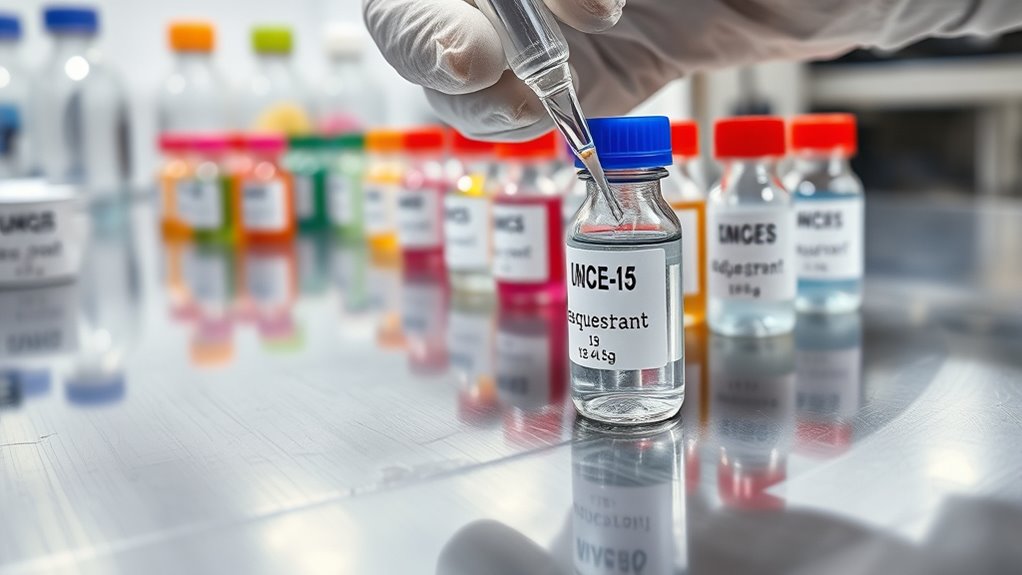
Have you ever wondered how metal contaminants are controlled in water and industrial processes? Sequestrants play a crucial role in this. They are chemical compounds that bind to metal ions, preventing them from reacting with other substances. When added to water, sequestrants form stable, soluble complexes with metals like iron, copper, and manganese. This prevents these metals from precipitating out as stains or forming scale, which can damage equipment. Sequestrants are especially useful because they don’t remove metals entirely but keep them in suspension, making them easier to manage and remove later. They’re widely used in water treatment, cleaning, and industrial processes to maintain system efficiency and prevent staining or corrosion caused by metal buildup.
Common Metal Sources in Household and Industrial Environments
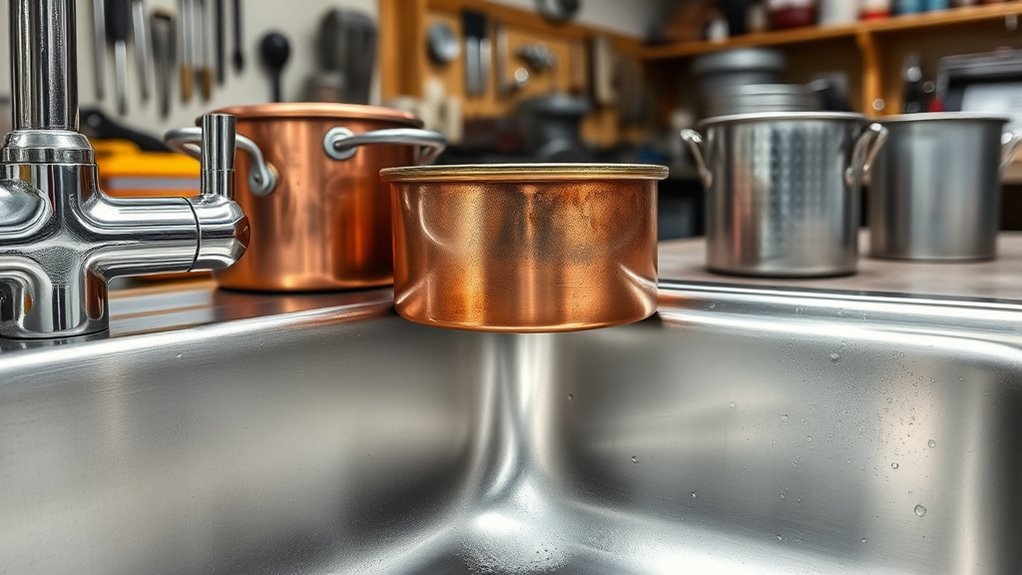
You encounter metal sources daily, such as plumbing and water fixtures that can introduce metals into your environment. Corrosion in equipment releases metals over time, while soil and environmental factors also contribute to metal presence. Recognizing these sources helps you manage metal levels effectively in household and industrial settings. Additionally, understanding the Power of Imagination can inspire innovative approaches to metal management and environmental sustainability.
Plumbing and Water Fixtures
Plumbing and water fixtures are essential components in both household and industrial settings, often made from various metals that guarantee durability and corrosion resistance. Common materials include brass, copper, stainless steel, and zinc alloys, each chosen for their strength and ability to withstand constant water contact. These fixtures serve as the primary contact points for water delivery, making them a significant source of metal leaching into the water supply. Over time, minerals, chemicals, and water quality can cause corrosion or tarnishing, releasing metals like copper and zinc into the water. Proper maintenance, use of sequestrants, and regular inspection help minimize metal release, ensuring water quality stays safe and preventing staining or damage caused by metal deposits.
Corrosion in Equipment
Corrosion in equipment is a common issue that arises when metals react with environmental factors like moisture, chemicals, or oxygen, leading to deterioration. In household settings, you might notice rust forming on tools, appliances, or pipes, especially if they’re exposed to water or humid conditions. Industrial environments also face corrosion from exposure to chemicals, acids, or pollutants that accelerate metal breakdown. Common metal sources include steel, iron, copper, and aluminum, all vulnerable under certain conditions. For example, steel and iron easily rust when exposed to moisture, while copper can develop patinas. Recognizing these sources helps you better protect your equipment through proper maintenance, coatings, or corrosion inhibitors, preventing costly repairs and extending the lifespan of your metal assets. Additionally, understanding regional corrosion risks can help tailor preventative measures to specific environments and conditions.
Soil and Environmental Factors
Soil and environmental factors play a significant role in determining how metals in household and industrial settings are affected over time. You’ll find that soil composition, moisture levels, and pH influence metal corrosion and leaching. For example, acidic soils accelerate metal deterioration, while alkaline conditions can slow it down. Water exposure from rainfall or groundwater can carry metals into the environment, increasing contamination risks. Industrial emissions and nearby waste disposal sites contribute to soil and air pollution, introducing metals like lead, cadmium, and mercury. Temperature fluctuations also impact metal stability, causing expansion and contraction that weaken protective coatings. Environmental conditions such as humidity and temperature variations significantly affect metal corrosion rates. Understanding these factors helps you anticipate potential metal degradation and implement effective management strategies, reducing environmental impact and prolonging equipment lifespan.
Types of Sequestrants and Their Uses

Have you ever wondered how metal systems prevent buildup and damage caused by dissolved minerals? Sequestrants are key tools in this process. They are chemical agents that bind to metal ions, preventing them from forming insoluble deposits. Common types include EDTA (ethylenediaminetetraacetic acid), which chelates a wide range of metals, and polyphosphates that target calcium and magnesium. Organic acids like citric acid also act as natural sequestrants, especially in food and cosmetic applications. Each type serves specific purposes: EDTA is often used in cooling systems and water treatment, while polyphosphates are popular in detergents. Selecting the right sequestrant depends on your system’s needs, water chemistry, and the metals you’re managing, ensuring *ideal* stain prevention and equipment longevity. Cybersecurity vulnerabilities during system outages highlight the importance of safeguarding your infrastructure to prevent disruptions.
How Metal Ions Cause Stains and Corrosion
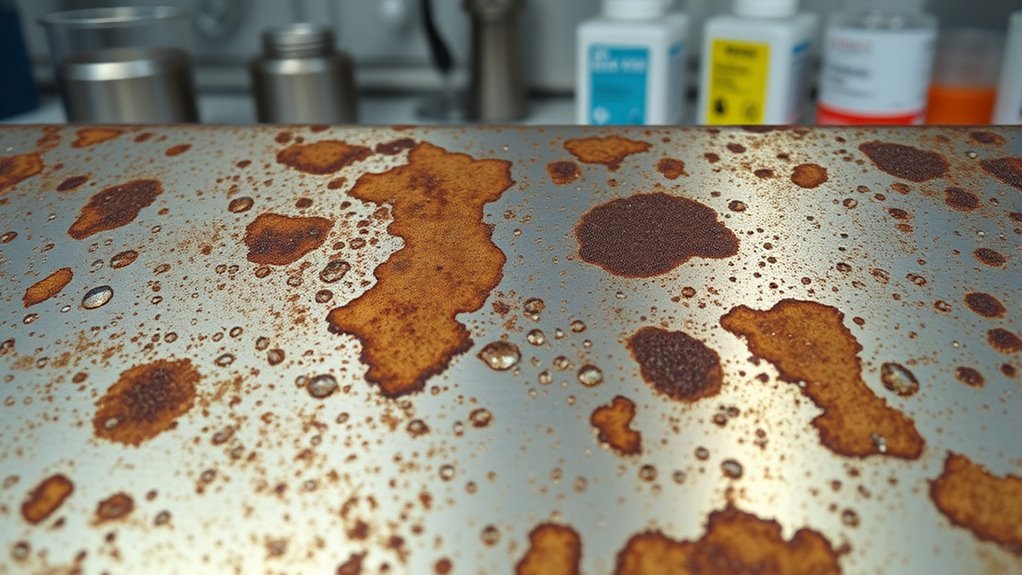
Metal ions in water can lead to unsightly stains and damage when they interact with surfaces. When these ions, like iron, copper, or manganese, come into contact with materials such as porcelain, glass, or fabrics, they often cause discoloration that’s difficult to remove. These ions can also accelerate corrosion by reacting with acids or salts, forming rust or other corrosion products. The process involves oxidation, where metal ions lose electrons and form insoluble compounds that settle on surfaces. Over time, this buildup weakens materials and causes pitting or surface degradation. The staining is often permanent if not treated early. Understanding how metal ions cause these effects helps you take initial steps to minimize damage, such as controlling water chemistry or using protective coatings. Incorporating corrosion prevention techniques can significantly extend the lifespan of affected materials.
Strategies for Preventing Metal Stains on Surfaces
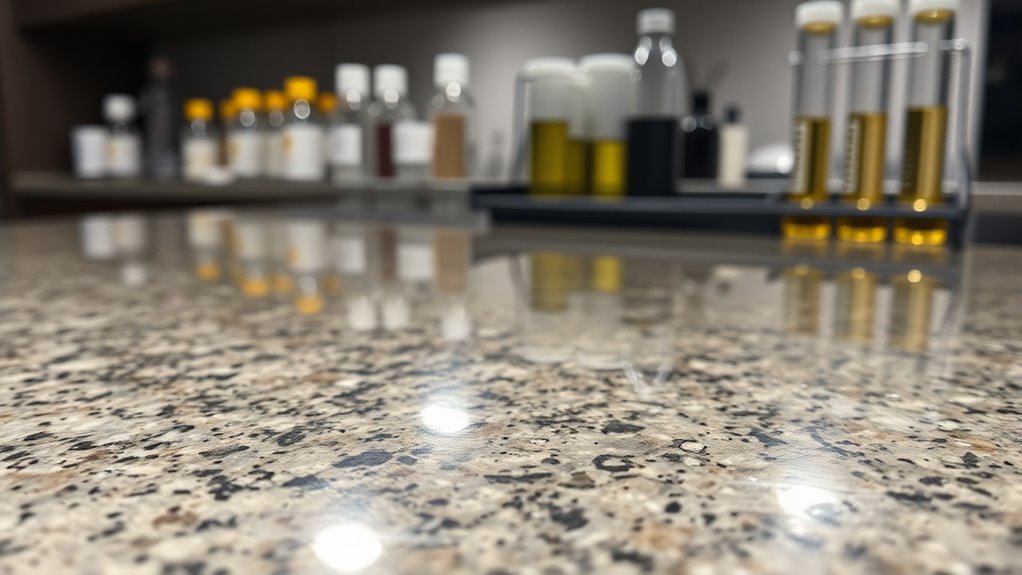
You can prevent metal stains by applying protective sealants that create a barrier against moisture and ions. Regular cleaning and maintenance also help remove corrosive elements before they cause damage. Together, these strategies keep your surfaces looking clean and free from unsightly stains. Incorporating expert voice actors into your messaging can also enhance the credibility of your informational content.
Apply Protective Sealants
Applying a protective sealant is one of the most effective ways to prevent metal surfaces from staining or corroding over time. Sealants create a barrier that blocks moisture, oxygen, and corrosive elements from reaching the metal. Before applying, clean the surface thoroughly to remove dirt, grease, and existing corrosion. Choose a sealant designed specifically for the type of metal you’re working with—whether aluminum, copper, or iron. Follow the manufacturer’s instructions carefully, applying an even coat using a brush, roller, or spray. Confirm complete coverage, especially on seams and edges. Allow the sealant to cure fully before exposing the surface to moisture or handling. Regular reapplication may be necessary to maintain prime protection, especially in high-humidity or outdoor environments. Ensuring proper color accuracy can also help in assessing the effectiveness of your protective measures.
Regular Surface Maintenance
Maintaining a clean and well-kept surface is key to preventing metal stains and corrosion over time. Regular cleaning removes dirt, grime, and corrosive residues that can accelerate staining. Use gentle, non-abrasive cleaners suited for your surface type and wipe down frequently. Inspect surfaces regularly for signs of corrosion or staining, addressing issues promptly. Applying protective coatings or sealants enhances resistance against moisture and pollutants. Consider the table below for common maintenance practices:
| Practice | Benefit |
|---|---|
| Frequent Cleaning | Removes corrosive buildup |
| Prompt Stain Removal | Prevents long-term damage |
| Reapplying Sealants | Maintains surface barrier against elements |
Additionally, choosing the right filter technology can help reduce airborne pollutants that may contribute to surface degradation.
Consistent maintenance keeps your surfaces looking pristine and prolongs their lifespan.
Best Practices for Managing Metals in Water Systems
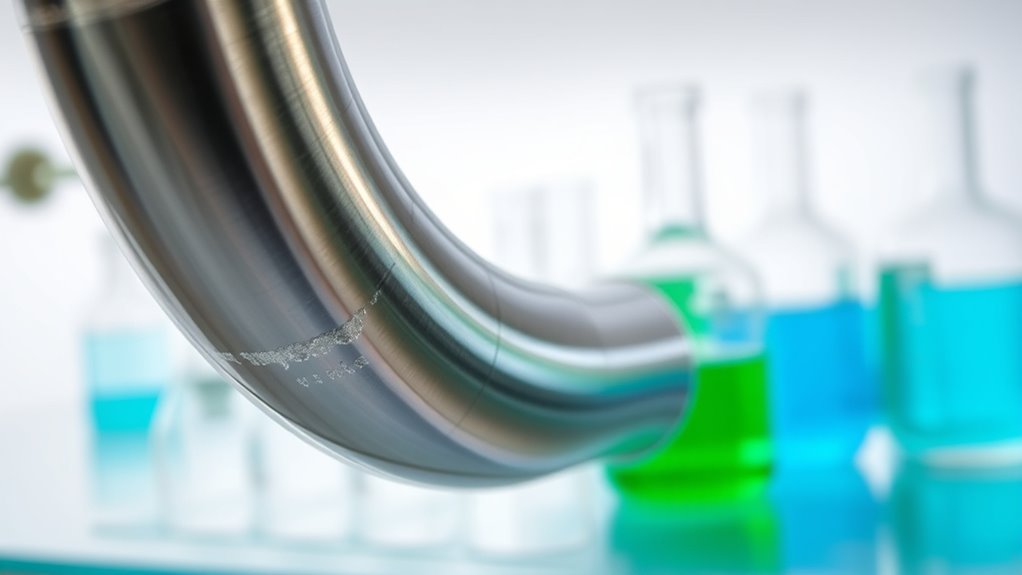
Effective management of metals in water systems begins with implementing extensive monitoring strategies to detect metal levels accurately. Regular testing helps you identify contamination sources and assess whether concentrations exceed safe limits. Once you have baseline data, establish a proactive maintenance schedule, including flushing pipes and cleaning fixtures to prevent buildup. You should also control pH levels and water chemistry to reduce metal solubility and corrosion. Using corrosion inhibitors and adjusting flow rates can minimize metal leaching. Educate your team about early signs of metal issues and maintain detailed records of water quality and maintenance activities. Consistent monitoring and timely interventions are vital for preventing staining, scaling, and system damage, ensuring safe, clean water for your facility. Incorporating water quality testing methods into your routine can further enhance detection accuracy and system reliability.
Selecting the Right Sequestrants for Different Applications
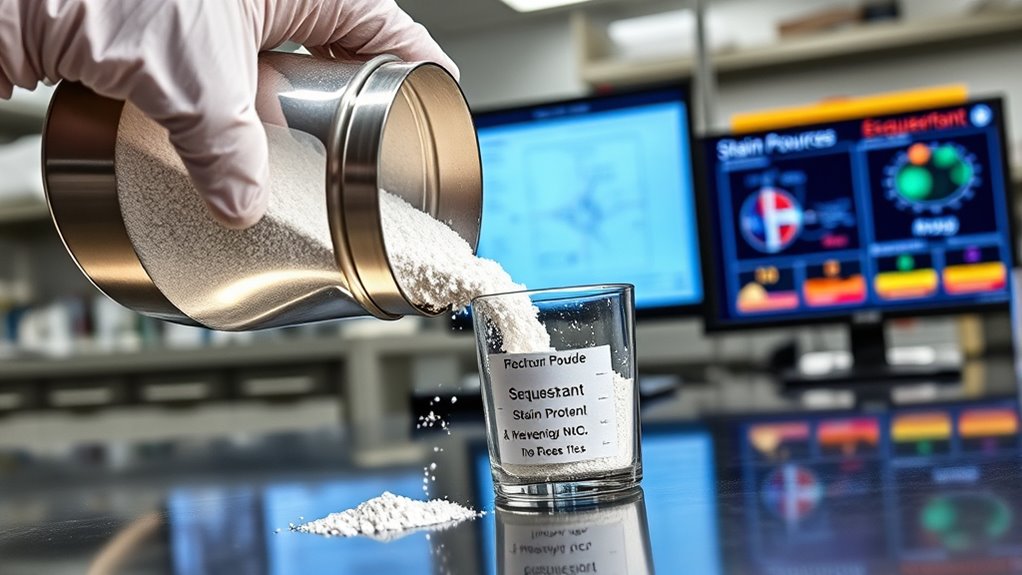
Choosing the right sequestrants depends on understanding the specific metals you need to control and the conditions of your water system. Different metals, like iron, copper, or calcium, require tailored approaches. For example, polyphosphates work well for calcium scale prevention, while chelating agents like EDTA are effective for complexing metals such as copper and iron. Consider factors like pH, temperature, and water hardness, which influence sequestrant performance. Some sequestrants perform better in high-temperature systems, while others are more stable across a range of pH levels. You should also evaluate compatibility with existing water treatment chemicals and system materials. By understanding these variables, you can select the most effective sequestrant to prevent staining, scale buildup, and metal corrosion in your specific application.
Practical Tips for Maintaining Metal-Free Surfaces
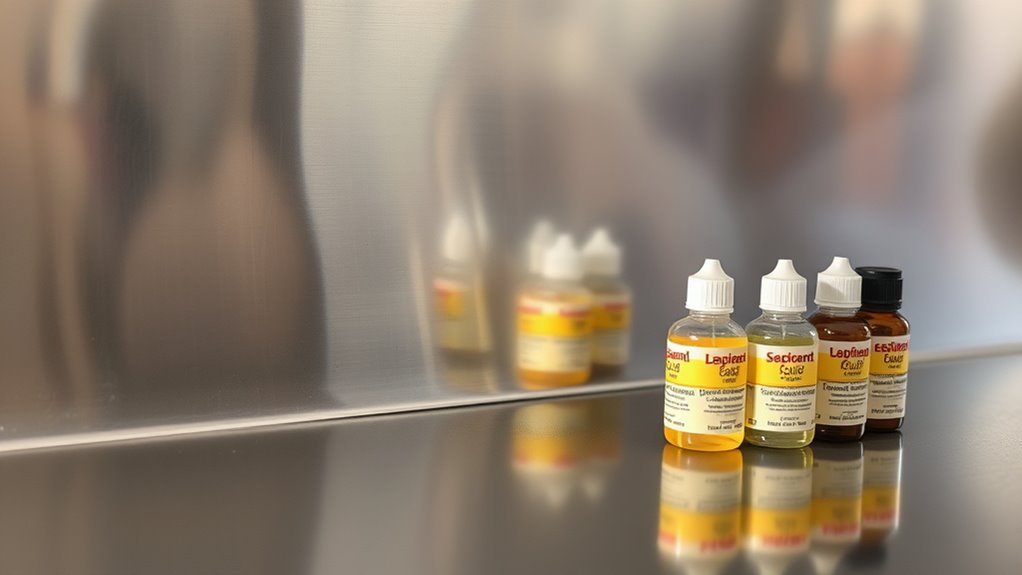
Regular inspection and timely cleaning are key to keeping metal surfaces free from staining, corrosion, and scale buildup. Make a routine to check for signs of corrosion or deposits, especially in high-use or hard-to-reach areas. Use gentle, non-abrasive cleaners that are compatible with your metal type to avoid damage. Wipe down surfaces regularly to prevent mineral deposits and residue accumulation. If you notice stains or corrosion starting to form, address them immediately with appropriate cleaning agents. Keep metal surfaces dry whenever possible, as moisture accelerates corrosion. Implement a maintenance schedule that includes both cleaning and protective treatments, such as applying corrosion inhibitors or sealants. Staying proactive helps extend the lifespan of your metal surfaces and keeps them looking pristine. Additionally, understanding the transformative power of decluttering can help you organize your maintenance supplies efficiently, making routine care easier and more effective.
Frequently Asked Questions
How Do Sequestrants Interact With Other Cleaning Chemicals?
Sequestrants interact with other cleaning chemicals by binding with metal ions, preventing them from reacting with stains or causing discoloration. When used properly, they enhance cleaning effectiveness without interfering with detergents or acids. However, if mixed improperly, they can form insoluble compounds, reducing cleaning power or causing unwanted residues. Always follow instructions and avoid combining sequestrants with incompatible chemicals to guarantee safe, effective stain prevention.
Are There Environmental Concerns With Using Metal Sequestrants?
Yes, there are environmental concerns with using metal sequestrants. You should consider their potential to persist in water sources, harm aquatic life, and contribute to pollution. When you use them, you’re releasing chemicals that may not break down easily, leading to long-term environmental impacts. To minimize harm, you can opt for biodegradable options, follow proper disposal procedures, and limit their use to reduce ecological risks.
Can Sequestrants Remove Existing Metal Stains Effectively?
Yes, sequestrants can effectively remove existing metal stains. They work by binding to metal ions, which helps lift stains from surfaces like plumbing fixtures, appliances, or fabrics. To achieve the best results, you should apply the sequestrant directly to the stained area, let it sit for the recommended time, and then scrub or rinse thoroughly. Keep in mind that some stains might require multiple treatments for complete removal.
What Are the Signs of Metal Contamination in Water Systems?
Think of your water system like a clear mirror suddenly clouded by a film. You’ll notice discoloration, often a rusty or brownish hue, indicating metal contamination. You might also see mineral deposits or staining on fixtures and appliances. Sometimes, water tastes metallic or smells odd, further signaling contamination. Regular testing and visual inspection help you catch these signs early, so you can address issues before they cause more damage or affect water quality.
How Often Should Metal Management Protocols Be Reviewed?
You should review your metal management protocols at least annually, or more often if your water system experiences changes like increased usage, new equipment, or shifts in water chemistry. Regular reviews ensure your strategies stay effective in preventing metal buildup and staining. Keep an eye on any signs of contamination or staining, and update your protocols promptly to address emerging issues and maintain ideal water quality.
Conclusion
By understanding how sequestrants work and managing metal sources effectively, you can prevent stubborn stains and corrosion. Regular maintenance and choosing the right products are key. Remember, an ounce of prevention is worth a pound of cure—staying proactive keeps your surfaces pristine and your systems running smoothly. With simple strategies, you’ll keep metal issues at bay and enjoy long-lasting, stain-free results.
